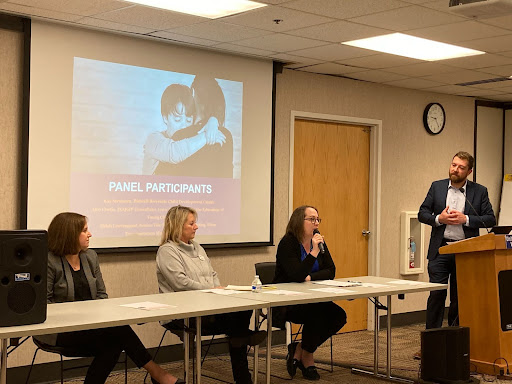Advocates, child care professionals call for sustainable change to support industry

Heidi Leavengood of Ruan Transportation Management Systems, Amy Curtis of the Iowa Association for the Education of Young Children, and Kay Stahorn of the Conmigo Early Education Center participate in a panel discussion on child care with Dave Stone, advocacy officer for the United Way of Central Iowa, on Tuesday. Photo by Michael Crumb
Actions taken over the past year to address the state’s child care crisis were “baby steps,” and more needs to be done, Dawn Oliver Wiand, president and CEO of the Iowa Women’s Foundation, said Tuesday.
Wiand helped moderate an hourlong conversation about child care, sharing data and proposed legislation for the 2023 session to address challenges facing the child care industry. More than 50 child care providers and advocates attended the conversation, held at the United Way of Central Iowa in Des Moines.
The conversation also included a panel discussion with comments from Kay Stahorn, director of the Conmigo Early Education Center, Amy Curtis, an ECQuiP consultant with the Iowa Association for the Education of Young Children, and Heidi Leavengood, senior vice president of accounting for Ruan Transportation Management Systems.
Before the panelists shared their comments, Wiand shared information from Childcare Resource and Referral to illustrate the depth of the state’s child care crisis.
Among the data was the fact that Iowa is No. 1 in the country in two-parent working households, at 75%. There are 519,713 children in Iowa between birth and 12 years old and only 173,481 available spaces in the state’s child care centers, resulting in a shortfall of more than 346,000 spaces.
The data also showed that Iowa has lost 28% of its child care businesses over the past five years, and 56% in the past 10 years.
The number of child care programs that accept child care assistance has also declined, down 34% in the past five years, and down 60% from 10 years ago.
In Polk County, 74% of families have both parents working outside the home, with a more than 53,000-space shortage for child care. Polk County has lost 25% of its child care businesses in the past five years, and lost 52% of those businesses in the past 10 years, the data showed.
“It’s showing that there is still a shortage of quality, affordable child care around our state and we need to figure out how we can address that,” Wiand said.
Even if a child care center has space available, they can’t fill the openings because they don’t have the staff, she said.
According to the data, the average wage of a child care worker in Iowa is $10.73 an hour, which Wiand said is unacceptable.
“This is the third-lowest profession in this state, just above locker room attendants and lifeguards,” she said. “We pay people more to take care of our hamburgers than we do our children.”
The national average pay for child care workers is $14.31 an hour.
“So we have a shortage of spaces and now we have a shortage of work staff,” Wiand said. “We need to do something about it.”
The data also showed that parents miss more than four days of work and are late more than seven times every six months because of child care. Sixty-three percent of parents said child care costs influenced their career decisions, with many human resource directors reporting that they’re having a difficult time hiring people because child care isn’t available in their area, Wiand said.
During the panel discussion, Stahorn said staffing and low wages are the top issues facing child care centers.
When an opening does come up, few resumes are received and the number of no-shows when an interview is scheduled is “super high.”
“It’s very difficult to hire,” Stahorn said. “If we can’t hire, then we don’t have full enrollment. And if we don’t have full enrollment, then our financial situation isn’t great. It feels sometimes like we’re on a slowly sinking ship. It’s not sustainable. There has to be some change, some real change to support centers.”
She said more resources are also needed to support children who are developmentally and socially delayed after being at home much of the time during the pandemic.
According to Stahorn, the help that came through federal COVID relief funds and other programs has been helpful, and the recruitment and retention bonuses “are so big for our staff morale. That’s been a huge boost.”
In her role, Curtis supports child care center directors and teachers, looking at lesson plans and classroom management tools.
“I’m looking at teachers who are barely making it to get in the door every day,” she said. “I think that’s probably my biggest concern, the mental health of our [child care workers].”
Curtis said she’s generally optimistic that things will improve, but recently began to feel “the rose-colored glasses slipping off to the point where I don’t know how child care is going to be sustainable in five to 10 years.”
“We can’t sustain it the way it is now,” she said.
Leavengood said Ruan has also had people not show up for interviews because they didn’t have child care, and have had employees leave the workforce because of child care issues.
Ruan was recently awarded a $940,000 Child Care Business Incentive Grant to develop a downtown child care center that would have slots for 150 children.
“We’re currently looking at how we can use that money and where we may be able to participate in building a child care center in downtown Des Moines,” Leavengood said.
She said Ruan is looking at what other businesses it can partner and what it can do “to really help with some of the child care situations we’re seeing downtown,” she said.
The Iowa Legislature last year passed three bills to address the child care crisis, including increasing the number of children that can be supervised by one person in a classroom and the hiring of 16-year-olds to work unsupervised.
Other measures included allowing parents to pay the difference between the child care assistance rates and rates paid by private-pay families. Another bill allowed child care assistance to be used by families in which one parent is permanently disabled so the other parent can work.
When asked if those measures had made a difference, Curtis said: “That falls into that ‘just because you can doesn’t mean you should.’”
Four recommendations for the 2023 legislative session were shared Tuesday.
- Invest in the child care workforce by identifying sustainable sources for increasing pay and implementing tax cuts and credits to incentivize people to work in child care.
- Support child care businesses by increasing child care assistance reimbursements.
- Increase income eligibility for child care assistance to 185% of the federal poverty level, up from 145%.
- Identify long-term funding to support more business incentive grants and implement tax incentives and credits to incentivize businesses to increase investments in child care.
Wiand said action taken at the federal and state level last year addressing child care were good “baby steps,” but that more is needed.
“But that was all done with pretty much one-time federal dollars, one-time funding that’s going to go away, and then what’s going to happen?” she said. “How are we going to address all the issues when federal dollars go away? What does that look like? That’s one of the things that we’re really going to be pushing hard with our legislators starting today until they go back into session.”











